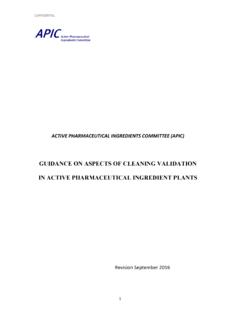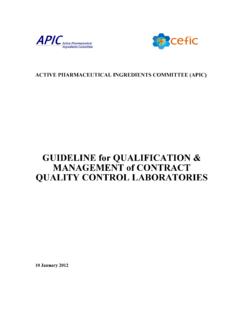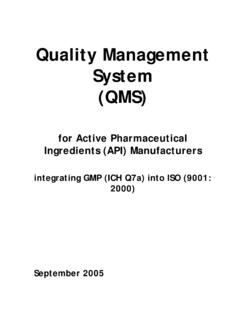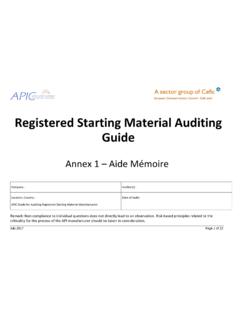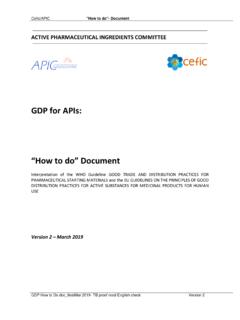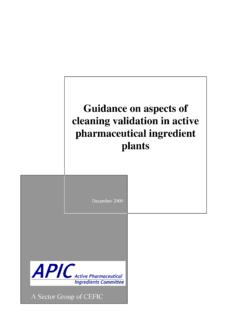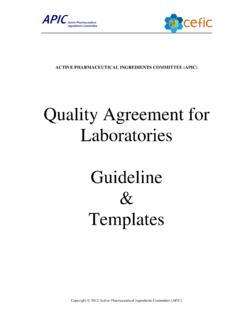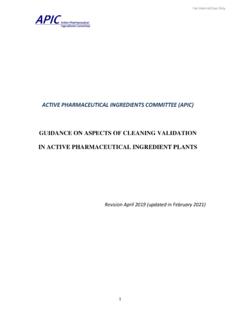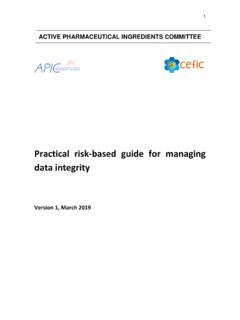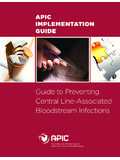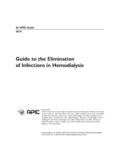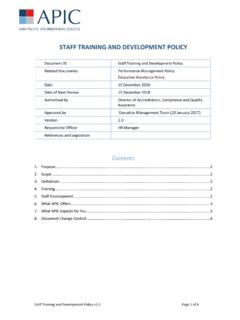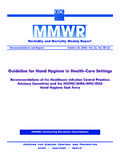Transcription of ACTIVE PHARMACEUTICAL INGREDIENTS …
1 ACTIVE PHARMACEUTICAL INGREDIENTS COMMITTEE ( apic ). eCTD HOW TO DO DOCUMENT. July 2014. APIC_eCTD How to Do Table of Content 1. CHAPTER 1: REGULATORY FRAMEWORK & NATIONAL Introduction: view of authorities in general & trend ..5. Requirements for the European Union ..5. Requirements for EU Countries ..6. European Medicines Agency (EMA) ..7. Requirements for the United States of America ..7. Requirements for Japan ..8. Requirements for 2. CHAPTER 2: OPTIONS & CONSIDERATIONS FOR API MANUFACTURERS TO. HANDLE E-CTD REQUIREMENTS ..9. Evaluation of current submission processes & tools.
2 9. Boundaries ..10. User Requirement Specification (URS) ..10. Selection of solution ..11. In-house Host system option / Software as a Service (SaaS) ..14. Outsourcing option ..15. Implementation ..18. Document management system (DMS) ..18. Creation of eCTD compliant documents ..19. Service agreement ..19. Users and Training ..19. SOPs ..20. Document Migration ..20. 3. CHAPTER 3: PREPARATION OF E-CTD READY DOCUMENT AND DOSSIERS ..21. Page 2. APIC_eCTD How to Do File Organisation for the eCTD (Granularity) ..21. Specification for Submission Formats.
3 24. Specification for Submission Formats ..24. Guidance on Text Searchable Documents ..27. Regional Requirements: Module 1 requirements for eCTD Migration of data into the new eCTD system ..31. Migration of documents ..31. Dossier migration into a SMS ..35. Table of Tables Table 1 :Comparaison of the 3 11. Table 2: Running an eCTD software in-house: advantages and disadvantages .. 12. Table 3: Host system option: advantages and disadvantages .. 14. Table 4: Outsourcing option: advantages and disadvantages .. 16. Table 5: Module 2 .. 21. Table 6 : Module 22.
4 Table 7 : Key items for the creation of eCTD compliant documents .. 25. Table 8 : Module 1 28. Table 9 : Module 1 information .. 29. Page 3. APIC_eCTD How to Do INTRODUCTION. eCTD is a topic of increasing interest in the PHARMACEUTICAL environment. In the past, the main focus for regulatory authorities was eCTD submissions sent via MAAs. As a result, introduction of eCTD by API manufacturers was slow with limited eCTD guidance for API dossiers. In recent times, however, the number of eCTD submissions for API manufacturers has increased (the FDA have reported an increase of eCTD submissions year on year) and guidance documents have been published that make it possible to create and maintain API dossiers using eCTD.
5 API. manufacturers are also beginning to understand the benefits from the adoption of eCTD. This document will focus on eCTD only as it is considered the upcoming standard for electronic submissions. There are other options for electronic submissions such as NeeS (Non eCTD. electronic Submission) in Europe or a single pdf-file. However, these submission types are not ICH-standard so their uses are limited when dealing with customers in different regions. It must be noted, however, that when it comes to eCTD submission, there continues to be differences among different countries and even ICH regions.
6 For example, the FDA began accepting eCTD submissions in 2003; Japan began accepting in 2004, yet the EU Heads of Medicines Agencies committed themselves, in 2005, to be ready for eCTD submissions by 2010. The approach of the different health authorities also continues to be different. For example, Japan has accepted eCTD since 2004 but eCTD submissions of API dossiers are not possible; in Europe, some agencies continue to require paper submissions for specific sections. Outside the ICH region, countries are continuing to adopt the eCTD initiative and there is potential for eCTD to become the standard for non-ICH countries.
7 Chapter 1 of this guideline document discusses region and country-specific requirements for eCTD. submissions, in particular the requirements for Module 1 of the dossier. These requirements are subject to change so this chapter should be considered as living' and will evolve over time to include additional countries when further eCTD guidance is published. Chapter 2 gives an overview of the 3 main ways in which a company can adopt eCTD. The advantages and disadvantages of introducing eCTD in-house or via a host server or to fully outsource eCTD are discussed.
8 Chapter 3 goes further and describes the requirements necessary for an eCTD ready' API dossier. Please note that this guideline document focuses entirely on the first submission of an API. dossier. Lifecycle activities are not considered. However the reader should understand that submission management of products throughout their lifecycle is a key aspect and needs to be considered from the very beginning. The authors hope this document will give the reader a basic understanding of eCTD, an understanding of the eCTD requirements expected by different Health Authorities and allows the reader to make an informed decision on how to implement eCTD.
9 Page 4. APIC_eCTD How to Do 1 CHAPTER 1: REGULATORY FRAMEWORK & NATIONAL. REQUIREMENTS. Introduction: View of Authorities in General The following chapter summarises the current format requirements for eCTD submission of DMF/ASMFs in the ICH countries (Europe: EDQM, EMA, national authorities, USA, Japan) and Canada. The spectrum of requirements among the above mentioned countries is highly variable. In Japan and Canada DMF submissions in eCTD format are still not possible. In Europe and the USA, eCTD. is considered the preferred submission format.
10 Furthermore, the EDQM offers alternative ways to submit DMFs in electronic format (NeeS, or single pdf for the whole submission), while this is not foreseen for FDA and EMA. Overall, a clear trend towards paper-free submissions, with preference for eCTD electronic format, is observed. Requirements for the European Union EDQM. General A choice has to be made between an electronic or paper submission, excluding any combination of both. It must be noted that paper submissions are scanned before validation of the application which may lead to a delayed clock start.
